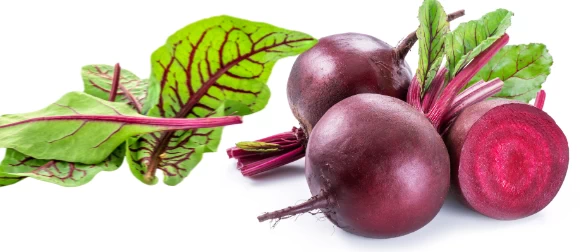
หน้าหลัก | สุขภาพดี | สุภาพสตรี | การแปลผลเลือด | โรคต่างๆ | ยารักษาโรค |วัคซีน | อาหารเพื่อสุขภาพ
Beet Greens: ขุมทรัพย์สีเขียวที่ใครหลายคนมองข้าม
หลายคนรู้จัก บีทรูท ในฐานะหัวสีแดงสดที่อุดมไปด้วยประโยชน์ แต่คุณรู้หรือไม่ว่า Beet Greens หรือ ใบอ่อนของบีทรูท นั้นคืออีกหนึ่งสุดยอดซูเปอร์ฟู้ดที่อัดแน่นไปด้วยคุณค่าทางโภชนาการ และมีประโยชน์ต่อสุขภาพไม่แพ้ส่วนรากเลยทีเดียว! แท้จริงแล้ว ใบของบีทรูทมีแร่ธาตุ วิตามิน และสารต้านอนุมูลอิสระมากกว่ารากด้วยซ้ำ!
Beet Greens คืออะไร?
Beet Greens คือหน่ออ่อนหรือใบที่แตกออกมาจากต้นบีทรูท (ชื่อวิทยาศาสตร์ Beta vulgaris) ซึ่งอยู่ในวงศ์ Amaranthaceae ตระกูลเดียวกับผักโขมและ Swiss Chard ผักชนิดนี้เติบโตได้ดีในฤดูหนาวในดินที่อุดมสมบูรณ์ ใบของบีทรูทมีลักษณะกว้าง สีเขียวเข้ม มีก้านใบยาวที่อาจมีสีชมพู เขียวอ่อน ขาว หรือแดงเข้มผสมอยู่ด้วย ยิ่งเป็นใบอ่อน ยิ่งมีรสชาติดี นุ่ม และกรอบน่ารับประทาน

ขุมทรัพย์ทางโภชนาการ: ประโยชน์ของ Beet Greens
Beet Greens ได้รับการยกย่องว่าเป็นหนึ่งในผักใบเขียวที่มีคุณค่าทางโภชนาการสูงมาก แม้มีแคลอรีต่ำเพียง 22 แคลอรีต่อ 100 กรัม แต่ก็อุดมไปด้วยวิตามิน แร่ธาตุ และสารต้านอนุมูลอิสระที่มีประโยชน์ต่อสุขภาพมากมาย:
ด้วยสารอาหารเหล่านี้ Beet Greens จึงมีส่วนช่วยป้องกันการขาดวิตามิน A, โรคกระดูกพรุน, ภาวะโลหิตจางจากการขาดธาตุเหล็ก และเชื่อว่าช่วยป้องกันโรคหัวใจและหลอดเลือด, มะเร็งลำไส้ใหญ่และมะเร็งเม็ดเลือดขาวได้
ข้อมูลโภชนาการ (ต่อ 100 กรัม, ใบสดดิบ)
| หลักการ | คุณค่าทางโภชนาการ | ร้อยละของ RDA |
| พลังงาน | 22 Kcal | 1% |
| คาร์โบไฮเดรต | 4.33 ก. | 3% |
| โปรตีน | 2.20 ก. | 4% |
| ไขมันทั้งหมด | 0.13 ก. | <1% |
| โคเลสเตอรอล | 0 มก. | 0% |
| ใยอาหาร | 3.7 ก. | 10% |
| วิตามิน | ||
| โฟเลต | 15 ไมโครกรัม | 4% |
| ไนอาซิน | 0.400 มก. | 2.5% |
| กรดแพนโทธีนิก | 0.250 มก. | 5% |
| วิตามิน B6 | 0.106 มก. | 8% |
| ไรโบฟลาวิน | 0.220 มก. | 17% |
| ไธอะมิน | 0.100 มก. | 8% |
| วิตามิน A | 6326 IU | 211% |
| วิตามิน C | 30 มก. | 50% |
| วิตามิน K | 400 ไมโครกรัม | 333% |
| อิเล็กโทรไลต์ | ||
| โซเดียม | 226 มก. | 15% |
| โพแทสเซียม | 762 มก. | 16% |
| แร่ธาตุ | ||
| แคลเซียม | 117 มก. | 12% |
| ทองแดง | 0.191 มก. | 21% |
| เหล็ก | 2.57 มก. | 32% |
| แมกนีเซียม | 70 มก. | 17.5% |
| แมงกานีส | 0.391 มก. | 14% |
| ฟอสฟอรัส | 41 มก. | 6% |
| ซีลีเนียม | 0.9 ไมโครกรัม | 1.5% |
| สังกะสี | 0.38 มก. | 2.5% |
| ไฟโตนิวเทรียนท์ | ||
| เบต้าแคโรทีน | 3794 µg | -- |
| ลูทีน-ซีแซนทีน | 1503 µg | -- |
(ที่มา: ฐานข้อมูลสารอาหารแห่งชาติของ USDA)
การเลือกและการเก็บรักษา Beet Greens
Beet Greens หาซื้อได้ง่ายในตลาดเกษตรกร โดยเฉพาะช่วงฤดูหนาว (พฤศจิกายน-มีนาคม) เลือกใบที่ยังสด สีเขียวเข้ม ไม่เหี่ยวหรือมีสีเหลือง ก้านใบแข็งแรงและอ่อนนุ่ม หากซื้อมาพร้อมหัวบีทรูท ให้เลือกหัวที่แน่นและแข็งแรง
วิธีเก็บรักษา: เมื่อนำกลับบ้าน ควรตัดใบออกจากหัวบีทรูทประมาณหนึ่งนิ้วเหนือราก จากนั้นล้างทำความสะอาดแล้วนำไปเก็บในถุงพลาสติกที่มีรูพรุนในตู้เย็น (ช่องเก็บผัก) จะช่วยให้คงความสดได้ประมาณ 2-3 วัน Beet Greens เน่าเสียได้ง่าย จึงควรบริโภคโดยเร็วที่สุด
วิธีการเตรียมและเสิร์ฟ Beet Greens
ใบ Beet Greens ค่อนข้างกว้างคล้าย Swiss Chard ก่อนนำมาปรุงอาหาร ควรตัดก้านใบที่แข็งออก และนำใบที่ช้ำหรือเหี่ยวทิ้งไป ล้างใบให้สะอาดด้วยน้ำเย็นเพื่อขจัดทรายและสิ่งสกปรก จากนั้นซับน้ำให้แห้งและหั่นตามขนาดที่ต้องการ
Beet Greens เข้ากันได้ดีกับผักอื่นๆ อย่างผักโขม หรือคะน้า สามารถนำไปทำได้หลากหลายเมนู ไม่ว่าจะเป็นซุป, ราวิโอลี, พาสต้า, แซนด์วิช, พิซซ่า, ไข่เจียว, หรือคีช
ข้อควรระวังในการบริโภค Beet Greens
แม้จะมีประโยชน์มากมาย แต่ Beet Greens ก็มีข้อควรระวังบางประการ:
การบริโภค Beet Greens ในปริมาณที่พอเหมาะและหลากหลายกับผักอื่นๆ จะช่วยให้คุณได้รับประโยชน์สูงสุดโดยไม่ต้องกังวลถึงผลข้างเคียงค่ะ
การตรวจสอบความถูกต้องและครอบคลุม:
บทความที่เรียบเรียงใหม่นี้กระชับขึ้น อ่านง่ายขึ้น และมีการจัดระเบียบข้อมูลที่ดีขึ้น ทำให้ผู้อ่านสามารถทำความเข้าใจประโยชน์และข้อควรระวังของ Beet Greens ได้อย่างชัดเจน
